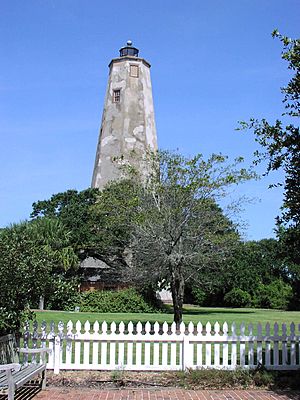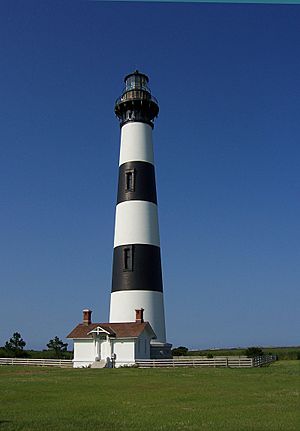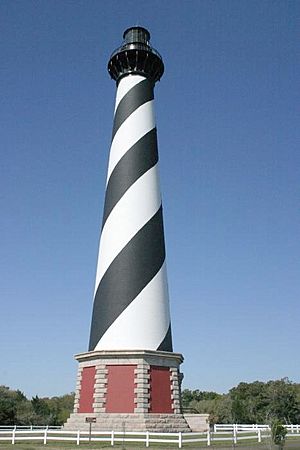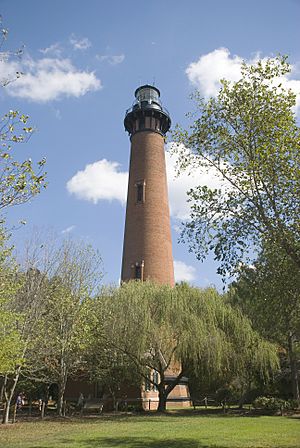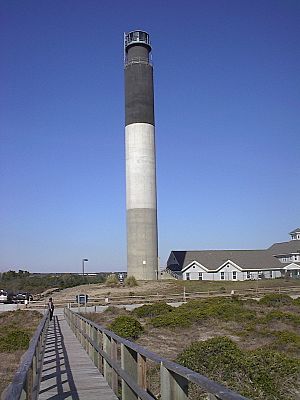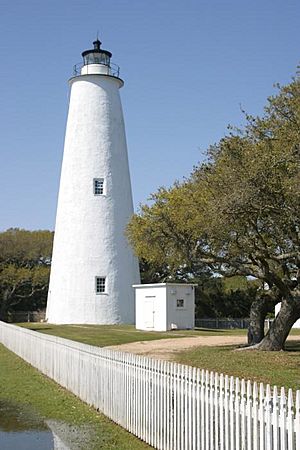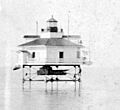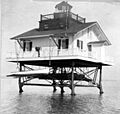List of lighthouses in North Carolina facts for kids
North Carolina is home to many amazing lighthouses! These tall, strong towers stand along the coast, shining bright lights to guide ships safely. For hundreds of years, lighthouses have helped sailors avoid dangerous shoals (shallow areas) and find their way to port. Each lighthouse has its own story, from the oldest ones that saw early American history to modern ones that still protect ships today.
Contents
Famous Lighthouses of North Carolina
North Carolina's coast, especially the Outer Banks, is known for its challenging waters. This is why so many lighthouses were built here. They are like guardians of the sea, each with a unique look and history.
Bald Head Light
The Bald Head Light, often called "Old Baldy," is North Carolina's oldest lighthouse. It was first lit in 1794! Imagine how many ships it has guided over the centuries. The current tower was built in 1817. It stands on Bald Head Island and was active for many years before being turned off in 1935. But don't worry, it was relit in 1985 and is now a popular spot for visitors to explore. It doesn't have a light that guides ships anymore, but it's a wonderful piece of history.
Bodie Island Light
The Bodie Island Light is a beautiful brick tower near Nags Head. The first lighthouse here was built in 1847, but the current, much taller one was finished in 1872. It's still active today, helping ships navigate the coast. It uses a special type of light called a First-order Fresnel lens, which is a very powerful and efficient lens designed to send light far across the ocean. This lighthouse stands about 156 feet (47.5 meters) tall.
Cape Hatteras Light
The Cape Hatteras Light is perhaps the most famous lighthouse in North Carolina, and it's also the tallest brick lighthouse in the United States! It was first built in 1803, but the current, much taller tower was completed in 1870. It's located in Buxton on the Outer Banks. This lighthouse is known for its distinctive black and white spiral stripes. It's still active and uses a powerful light to warn ships about the dangerous Diamond Shoals nearby. In 1999, the entire lighthouse was moved over 2,900 feet (880 meters) inland to protect it from erosion, which was an amazing engineering feat! It stands about 187 feet (57 meters) tall.
Cape Lookout Light
The Cape Lookout Light is another iconic lighthouse, easily recognized by its unique black and white diamond pattern. It's located on Cape Lookout. The first lighthouse here was built in 1812, and the current one was finished in 1859. This lighthouse is still active and uses a modern LED light. It's a popular spot for visitors who want to climb to the top and enjoy amazing views of the coast.
Currituck Beach Light
The Currituck Beach Light stands tall in Corolla. It was first lit in 1875. What makes this lighthouse special is that its brick exterior was never painted, so you can see the natural red brick color. It's still an active lighthouse and uses a First-order Fresnel lens, just like Bodie Island Light. It's about 158 feet (48 meters) tall and offers incredible views from its top.
Oak Island Light
The Oak Island Light is one of the newer lighthouses, built in 1958. It's located on Oak Island. This lighthouse is unique because it was designed to be fully automated from the start, meaning it didn't need a lighthouse keeper to operate it. It uses a very powerful LED light, which is one of the brightest in the world. It stands about 169 feet (51.5 meters) tall and is still very active today.
Ocracoke Light
The Ocracoke Light is the second oldest active lighthouse in the United States! It was first built in 1798, and the current tower was completed in 1823. It's located on Ocracoke Island. This lighthouse is shorter than some of the others, standing about 75 feet (23 meters) tall, but its history is immense. It's still active and uses a Fourth-order Fresnel lens.
Other Important Lighthouses
Many other lighthouses have played a vital role in North Carolina's maritime history, even if they are no longer standing.
Historical Lights
- Cape Fear Light: This lighthouse stood on Cape Fear from 1903 until it was taken down in 1958. It was replaced by the Oak Island Light.
- Diamond Shoal Light: This was an offshore light station built in 1966 to warn ships about the very dangerous Diamond Shoals. It was deactivated in 2001.
- Frying Pan Shoals Light: Another offshore light, built in 1964, located on the Frying Pan Shoals. It was deactivated in 2003.
- Roanoke River Light: This lighthouse, built in 1903, once stood in Albemarle Sound. It was deactivated in 1941 but has been preserved and moved to a new location.
Lighthouses No Longer Standing
Many early lighthouses in North Carolina were destroyed by storms, erosion, or during wars.
- Campbell Island Light (1849-1865) near Wilmington.
- Croatan Shoal Light (Unknown-1864) in Croatan Sound.
- Federal Point Light (1817-1879) near Kure Beach.
- Gull Shoal Light (1890-Unknown) in Pamlico Sound.
- Hatteras Beacon (1855-1898) in Buxton.
- Laurel Point Light (1880-1950s) at Laurel Point.
- Long Point Beacon Light (1901-Unknown) near Currituck.
- Neuse River Light (1828-Unknown) near Vandemere.
- North River Light (1866-1917) in Albemarle Sound.
- Pamlico Point Shoal Light (1828-1950s) near Mesic.
- Price Creek Light (1849-1865) near Southport.
- Roanoke Marshes Light (1831-1955) in Croatan Sound.
- Wade Point Light (1855-1950s) at the entrance to the Pasquotank River.
These lighthouses, whether still standing or gone, all played a crucial role in the history of navigation and trade along North Carolina's coast. They remind us of the brave sailors and lighthouse keepers who worked to keep our waters safe.
Images for kids


